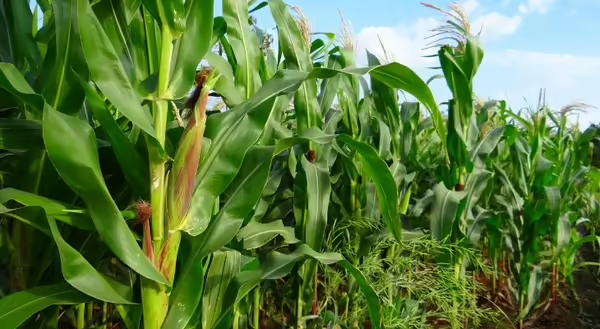
Driving through the country this time of year, you’re likely to see two things: corn and soybeans. In 2023, 11.2 million acres of land in Illinois were planted in corn and nearly 10.4 million acres in soybeans. These two crops make up the vast majority of our agricultural production in Illinois. The next most planted crop, wheat, only saw 840,000 acres planted in 2023. This is to say that over 60% of the land in Illinois is in a monoculture, whether that is corn, soy, or wheat. The way we have traditionally farmed has not focused on maintaining biodiversity in agroecosystems, but research has shown that biodiversity plays a critical role in the resiliency of our cropping systems.
What is biodiversity?
Biodiversity refers to the variety of life found on Earth in all its forms. It encompasses all living things, what they’re made of, and how they interact with each other. Biodiversity can be broken down into different levels—genetic, species, and ecosystem. Farmland is an ecosystem (usually referred to as an agroecosystem) made up of different species. Some of these species are easy to think of (like corn and soy), but this would also include insects, nematodes, bacteria, and fungi in the soil. Agroecosystems also have genetic diversity in the cultivars we plant, the weeds that grow, and the pest populations that damage crops. While in some ways agroecosystems are less complex than natural systems, they have their own unique set of interactions and challenges. It is important for growers to understand biodiversity because it underpins the foundation of our cropping systems.
Why is biodiversity in commercial agriculture important?
To understand why biodiversity is important in our agricultural systems, we first need to discuss ecosystem services. Ecosystem services are the benefits that humans receive from healthy ecosystems. They can be grouped into four categories—provisioning services, regulating services, supporting services, and cultural services. Provisioning services are the tangible goods that we get from ecosystems, like food, fiber, and fuel. Regulating services are the different processes that ecosystems perform, like climate regulation and carbon sequestration. Supporting services include processes like nutrient and water cycling and soil formation. Finally, cultural services are the more intangible benefits we receive from ecosystems, like recreation or aesthetics. Agroecosystems provide all of these services to us. They produce food, regulate climate, sequester carbon, cycle nutrients, and form soils. Biodiversity is needed to provide these services. Genetic diversity in crops and livestock provides a larger gene pool with traits that include disease resistance, higher yields, and resiliency to environmental stressors. Species diversity in our agroecosystems helps combat pests and diseases and makes our agricultural system more resilient to climate change. There can even be ecosystem-level biodiversity in our agricultural systems by incorporating practices like agroforestry and prairie strips.
If we want to continue to reap the benefits we get from agroecosystems, we need to increase biodiversity on farmed land. Biodiversity is the foundation which our agricultural systems are built on. It provides genetic resources, and ecosystem services, and improves the overall resiliency of our cropping system. Maintaining and increasing biodiversity in commercial agriculture is essential for long-term productivity, sustainability, and food security.
What can growers do to increase biodiversity on their farms?
Growers can increase biodiversity on their farms in many ways. One option is incorporating diverse crop rotations. Growers can work within the bounds of a standard corn/soy rotation but add cover crops between their cash crops. This adds more species diversity to the agroecosystem by not only including more plants, but fostering an environment that will lead to increased insect and microbial diversity. Another option is to incorporate different types of livestock, which can be used to graze down a cover crop before planting. Biodiversity can also be increased using edge-of-field practices, like vegetated buffers and prairie strips, that don’t take away from the land in production. Many edge-of-field practices help increase not only plant diversity but also insect and wildlife diversity by providing habitat.
As we move towards a more sustainable and resilient agricultural system, biodiversity will be one important part of the puzzle. Growers should consider what changes they can make to their operation—big or small—that can work towards these goals.
Emily Hansen is a Commercial Agriculture Educator with University of Illinois Extension, serving Bureau, LaSalle, Marshall, and Putnam counties. Emily provides research-based educational programs that empower growers to make sustainable choices on their farms.
Altieri, M. A. (1999). The ecological role of biodiversity in agroecosystems. In Invertebrate biodiversity as bioindicators of sustainable landscapes (pp. 19-31). Elsevier.
fao.org. (n.d.). The State of the World’s Biodiversity for Food and Agriculture 2019. www.Fao.Org. Retrieved June 18, 2024, from http://www.fao.org/state-of-biodiversity-for-food-agriculture/en
Kazemi, H., Klug, H., & Kamkar, B. (2018). New services and roles of biodiversity in modern agroecosystems: A review. Ecological indicators, 93, 1126-1135.
Moonen, A. C., & Bàrberi, P. (2008). Functional biodiversity: An agroecosystem approach. Agriculture, ecosystems & environment, 127(1-2), 7-21.
USDA/NASS 2023 State Agriculture Overview for Illinois. (n.d.). Retrieved June 18, 2024, from https://www.nass.usda.gov/Quick_Stats